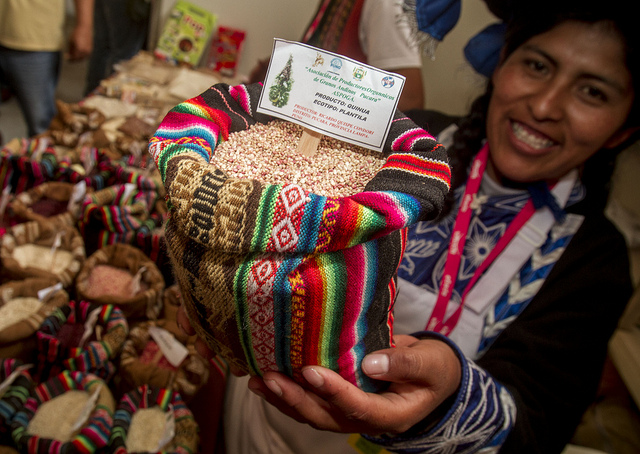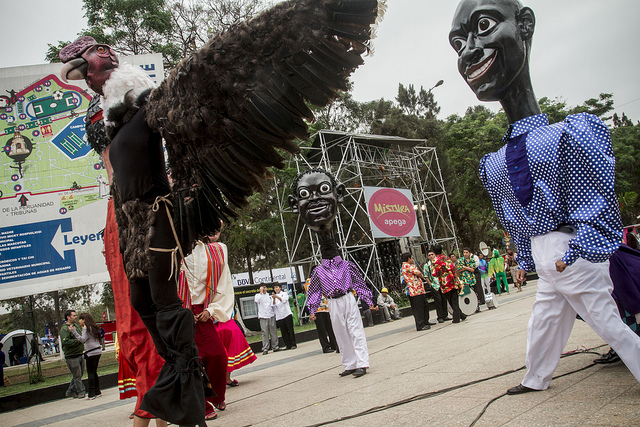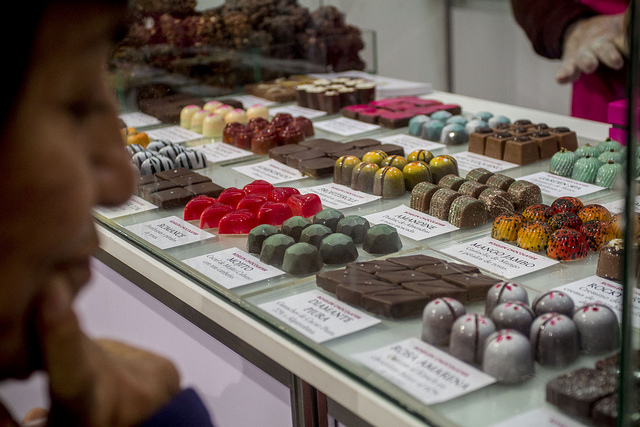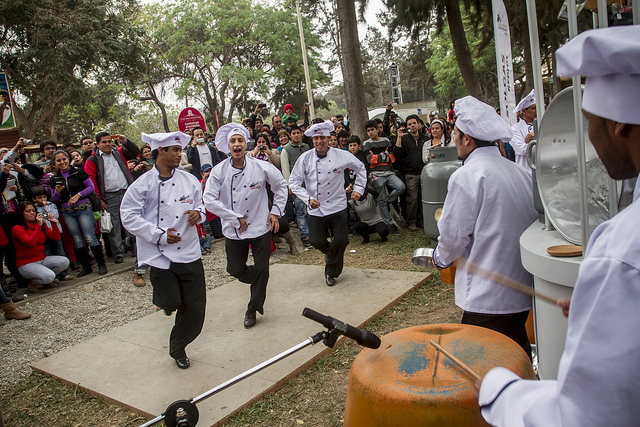[Translator's note: All links forward to websites in Spanish, unless stated otherwise.]
‘Mistura’, Peru's Gastronomy Fair, opened its doors in Lima for the fifth consecutive year [en], hoping not only to repeat its past success but also to increase the number of visitors, this year estimated at 600,000.
Mistura, organized by the Peruvian Gastronomy Association (Apega), has grown rapidly and now is considered the most important gastronomy fair in all Latin America.
Peruvians are very proud of their fair [en] since they highly value their gastronomy: as a reference, Mistura's Facebook page already has more than 409,000 subscribers.
During the opening ceremony, Nadine Heredia, Peru's First Lady, pointed out that Mistura “gives new value to our diversity” and called upon cooks to create an “Andean diet” that favours nutritional content for children.
Mistura 2012 gathers 54 restaurants, 70 food carts, 16 rustic kitchens, and an area called “great market”, where the main products and ingredients of Peruvian cuisine are sold. In addition to lectures by international guests, there are plenty of other programmed activities devoted to regional cuisines, traditional food and beverages, contests, prizes, and music shows.
Quoting Mistura's organizers:
Aquí se reúnen los diversos actores de la cadena gastronómica: pequeños agricultores, cocineros, panaderos,vivanderas, dulceras, mozos, restaurantes, institutos de cocina, comensales, entre otros; para rendirle homenaje a nuestra biodiversidad, una de las más ricas del planeta.
Nada de esto sería realidad sin el esfuerzo de nuestros hermanos campesinos […] A este esfuerzo se suma el generoso aporte de los distintos estilos culinarios de las diferentes regiones de nuestro país, así como el de las cocinas europeas, árabes, chinas, japonesas y africanas, que han nutrido a nuestra gastronomía convirtiéndola en una de las más variadas del mundo y de la cual nos sentimos muy orgullosos.
Here are brought together the different actors in the gastronomic chain — small farmers, cooks, bakers, street vendors, sweets sellers, waiters, restaurants, culinary institutes, patrons, among others — to pay tribute to our biodiversity, one of the richest in the world.
None of this would be possible without the effort of our fellow farmers […] To this effort we add the generous contribution of all the diverse culinary styles coming from the different regions of our country, as well as from the European, Arabic, Chinese, Japanese, and African cuisines, which have nourished our gastronomy making it one of the richest in the world and a great source of pride for us.
The main protagonists of Mistura 2012 are Andean grains, explains Bernardo Roca Rey Miró Quesada, the director of Apega.

Quinoa, the Peruvian grain with the highest protein content. Photo by APEGA under Creative Commons (CC BY-NC-SA 2.0)
The blog Marcamasi explains further:
Más de 350 productores mostrarán al mundo nuestra gran biodiversidad: cerca de 200 stands con productos de la costa, sierra y selva. Para ello, Apega trabaja con CONVEAGRO, la Asociación Nacional de Productores Ecológicos (ANPE), el Ministerio de Agricultura, la Universidad Nacional Agraria y asociaciones de pequeños agricultores. Triciclos panaderos y un Rincón del Chocolate con más de 30 expositores […]
This edition of Mistura comes with some singular novelties, like the very entertaining “Dance of the Bakers“, who celebrate with joy their work and their products.
The Twitter user Reportera Repostera (@Reporterarepost) comments:
@Reporterarepost: En el bulevar de la dulzura de #Mistura, no solo hay dulces buenos, sino también buenas historias q escuchar de los reposteros
Going to Mistura has become a habit for the locals; therefore, some bloggers even post tips and suggestions to have a better time, like Paloma on her blog Miss Cupcakes.
Foreign visitors are also attracted by the fair: many travel agencies include it in their tours, and the foreign community residing in Peru follows it closely, as Eric Ludy [en] comments in a post about the subject on the Facebook group “Expatriates in Peru” [en]:
Definitely worth a trip. As the others say, the lines are dreadful, but where else can you get Gaston's ceviche or a seafood medley from Amoramar for only 6 soles? We're talking gourmet for the masses here. And when I went I managed to buy a scalped entrance ticket outside for only 20 soles.
Recognition to the reach and achievements of Mistura comes also from foreign countries. From Spain, Erika Silva comments on her blog Marketing Gastronómico:
Cada año me sorprende más o más bien, me agrada más el trabajo que está haciendo Mistura, la feria gastronómica más grande de Lationamerica y a mi parecer, el modelo de negocio más acertado para una feria de gastronomía… Una feria que valora el esfuerzo de todas las personas que trabajan en el sector, no sólo de los chefs, ya comienza bien y su destino no puede ser otro que tener el éxito que está teniendo.
Even the international organization Oxfam America (@OxfamAmerica) [en] comments in its Twitter page:
@OxfamAmerica: The main ingredient of Peruvian cuisine is small agriculture. It generates 60% of the food consumed in Peru @MisturaPeru#Mistura
Nevertheless, as it has happened in all previous editions [en], with all the praise also come criticisms and controversy; this year they have focused on the supposed ecological damage that the fair will cause in its surroundings.
Given that Lima lacks an appropriate fairground for events this size, this year they fitted out the “Campo de Marte” (Field of Mars), one of the most emblematic parks of the city. The fact that has generated more contention is the dismantling of some areas of the park to cover them with concrete platforms on which to install the fairground.
The president of Apega, Bernardo Roca Rey, has stressed that the ecosystem of the Field of Mars will be respected; in spite of this, Facebook users like Patricia Loyola Campos started a campaign on social networks that began with the posting of a series of pictures that cast doubt on the supposed temporary nature of the structures.
Even if most people seem to support and appreciate this gastronomy fair, there's still a sector that doesn't agree with what Mistura has to offer, holding opinions like this one from Edwin on his blog La Vida Diaria de Edch (“Edch's everyday life”) in a post called “Gula y Prepotencia” (“Gluttony and Arrogance”):
me niego a aceptar que la cocina peruana pueda ser la solución a la gran brecha social y económica que sufre nuestro país desde el inicio de su vida republicana […] además, la comida al convertirse en un producto tiende a diferenciar, se quiera aceptar o no […] Segundo, la necesidad de rescatar a los pequeños vendedores y de cocineros regionales me parece insuficiente […] si realmente se quisiera incluir a los peruanos como tales y no solo a los limeños, cada edición de Mistura se debería realizar en una ciudad diferente cada año, con lo cual se tendría una cocina local como estrella y las demás como invitadas, además promovería el turismo a lo largo y ancho del país…
There are also posts that comment that it is not necessary to go to these fairs, because you can find authentically popular traditional and homemade food on every corner of Peru. But for people in Lima the best thing to do is to visit the fair and see for themselves all the activities going on and, of course, taste some of the best Peruvian cuisine.











4 comments
Thank you for mentioning my blog and my thoughts! Mistura is the greatest food show of the world.
Greetings from Spain!
Erika
The problem with mistura 2012 in “the fields of mars” is very simple: APEGA has broken the law, there is a law which protect the urban green area and specifically the fields of mars !!! you can look for it at the Peruvian national congress website… is very sad that some people hide the real facts just to make money…what you think foks? is it right? what about the constitution and the law ? money money money ,… just think about it Bernanrdo Roca Rey is a rich guy in a poor country , and is trying to tell the word that his business is not to produce money!!! i find this hard to believe their are telling only their part of the picture. (http://www.congreso.gob.pe/ntley/Imagenes/Leyes/16979.pdf)